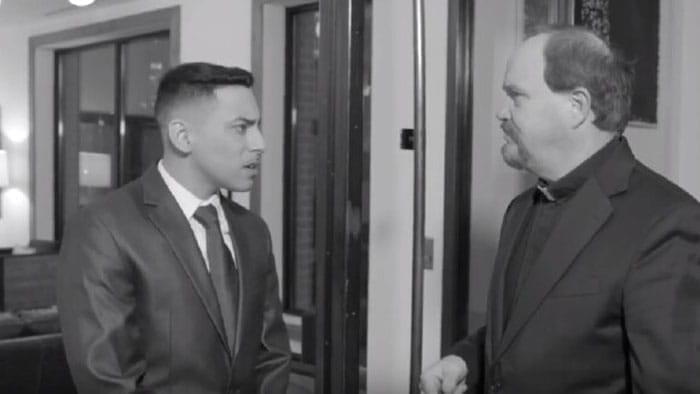
BOOTLEG FILES 128: “At Long Last Love” (1975 musical with Burt Reynolds and Cybill Shepherd).
LAST SEEN: We cannot confirm the last public screening.
AMERICAN HOME VIDEO: None.
REASON FOR DISAPPEARANCE: A notorious box office disaster.
CHANCES OF SEEING A DVD RELEASE: Not a priority.
BOOTLEG OPPORTUNITIES: Search eBay, if you must.
The 1975 musical “At Long Last Love” has been out of official circulation for so many years that most folks only know of it by reputation. And that reputation includes prominent placement in such books as “The 50 Worst Films of All Time” and “The Golden Turkey Awards.” The movie is also remembered for simultaneously killing the careers of its director and star.
But is “At Long Last Love” really that bad? The answer is: somewhat. It should be emphatically stated that the film is not, by any stretch of the imagination, a successful endeavor. But it deserves credit for attempting to be different and it offers several amusing supporting performances which got overlooked in the critical maelstrom swirling around its disastrous theatrical run.
The man who sailed “At Long Last Love” into ruin was Peter Bogdanovich, who had been riding a winning streak since his acclaimed 1968 “official” debut “Targets” (he had previously directed the 1966 Mamie Van Doren sci-fi romp “Voyage to the Planet of the Prehistoric Women” under a pseudonym). With flicks such as “The Last Picture Show,” “Directed by John Ford” “What’s Up, Doc?” and “Paper Moon” to his credit, Bogdanovich was the reigning director of the early 1970s. His ambitious 1974 costume drama “Daisy Miller” was not commercially successful, but many critics admired the production and it earned the reputation of being a distinguished failure.
Bogdanovich had a taste for nostalgia and it showed in some of his movies: “What’s Up, Doc?” recalled the screwball comedies of the 1930s and “Paper Moon” was evocative of the cynical Preston Sturges comedies. Even his decision to shoot “The Last Picture Show” and “Paper Moon” in black-and-white (at a time when all Hollywood productions were in color) showed Bogdanovich’s desire to stay connected to distant decades. For “At Long Last Love,” he opted for a return trip to the 1930s, this time to recreate the dreamworlds of the Astaire-Rogers musicals.
To his credit, Bogdanovich decided to use the music of Cole Porter as the score for “At Long Last Love.” But not the bowdlerized songs that turned up in the movies – rather, Bogdanovich used the original lyrics that were judged too racy by the Hollywood censors of the 1930s and 1940s (but which were quite tame by 1975 standards). Sixteen songs were chosen, ranging from classics like “Let’s Misbehave” and “I Get a Kick Out of You” to intriguing lesser works like “Most Gentlemen Don’t Like Love” and the title song (which was rarely performed owing to an allegedly jinxed history – Porter wrote it to distract himself from excruciating pain while he was awaiting medical help after his legs were crushed in a riding accident).
But where Bogdanovich goofed first was his curious decision to record all of the musical numbers live, rather than have his cast lip-sync to a pre-recorded track. The fact that no musical was recorded live since 1932 might have suggested that lip-syncing worked. Of course, sometimes a live performance can have more emotional resonance, most notably Barbra Streisand’s astonishing finale number “My Man” in “Funny Girl.”
But where Bogdanovich goofed next was casting a star who lacked Streisand’s musical talent. Bogdanovich decided to put his then-lover Cybill Shepherd in the leading role. The two first worked together on “The Last Picture Show,” but while his star rose her’s stagnated. Bogdanovich tried to elevate her value by putting her in the title role of “Daisy Miller,” but she was grossly miscast there. As a latter-day Ginger Rogers, Shepherd wasn’t better cast for “At Long Last Love.”
To play the male lead, Bogdanovich first considered himself (huh?), then vainly tried to get Elliott Gould. He wound up with Burt Reynolds, who was the reigning male star of that time. Reynolds achieved the impossible here – he made Shepherd seem like a natural musical comedy icon in comparison to his own off-key singing and two left feet.
The idea of having two people who cannot sing and dance perform a series of song and dance numbers is astonishing; with the exception of Lucille Ball in “Mame,” it is impossible to recall any other performers who were so horribly cast in a musical as Reynolds and Shepherd.
The plot of “At Long Last Love” is fairly dumb: millionaire playboy Michael Oliver Pritchard III (Reynolds) is in love with Broadway star Kitty O’Kelly (Madeline Kahn). Heiress Brook Carter (Shepherd) has the hots for card shark Johnny Spanish (Dulio del Prete). After dual madcap romances, the couples realize they are mismatched and they change partners. Simultaneous to this, Brook’s maid (Eileen Brennan) has the hots for Michael’s valet (John Hillerman) and wildly pursues him. All of this involves the singing and dancing of those 16 Cole Porter tunes at various parties, outings, shopping sprees and bathroom hygiene applications. And that is about it – the film is plotless, foolish and only exists to bridge one musical number to the next.
In retrospect, “At Long Last Love” might have worked had Reynolds and Shepherd not been in the film. Reynolds was too coarse and smug to be sympathetic as the playboy, while Vincent Canby of the New York Times hit the nail on Shepherd’s acting: “Casting Cybill Shepherd in a musical comedy is like entering a horse in a cat show. She’s beautiful and lithe and has great lines but she’s the wrong species.”
Where the film does work, and actually works rather well, is in the supporting cast. Madeline Kahn, as usual, steals the film and has no problem with Porter’s wicked songs (particularly her solo “Find Me a Primitive Man”). Italian singer/actor Duilio del Prete (who was memorable as the callow gigolo in Bogdanovich’s “Daisy Miller”) is a handsome presence and is able to find the charm in his solo number, “Tomorrow.” Eileen Brennan and John Hillerman are truly hilarious in their sideline romance – they have two versions of “But in the Morning, No” which serves as a grand reminder of their strong comic talents (particularly Hillerman, who was never funnier).
“At Long Last Love” also has a rich art deco production design that is evocative of the 1930s. I don’t know if Bogdanovich wanted to shoot the film in black-and-white, to emulate the Astaire-Rogers films, or if he was contractually prevented by his studio (20th Century Fox) from doing so. In any event, the art direction and cinematography are richly served and probably would’ve received Academy Award nominations had the film not been such a box office disaster.
And, boy, what a disaster that was! “At Long Last Love” opened in Easter 1975 at New York’s Radio City Music Hall to the most withering reviews any film ever received. The reaction was so negative that Bogdanovich took out an advertisement in the Hollywood Reporter to offer a half-hearted apology for making the film. Even the unflappable Reynolds (who was no stranger to making bad movies) publicly observed: “I think we bombed.”
The wreckage of “At Long Last Love” left several victims. The releasing studio, 20th Century Fox, lost most of its $6 million investment (a huge sum for 1975) and its two-record soundtrack was a disaster. Bogdanovich was pegged as an out-of-control megalomaniac, and the failure of his next movie “Nickelodeon” (a 1976 Columbia release also starring Burt Reynolds) ended his viability with the studios. Bogdanovich had to get financing from Roger Corman, of all people, to make his 1979 Singapore-based “Saint Jack,” but then he achieved the impossible – he went overbudget for a Roger Corman movie. Aside from directing “Mask” in 1985 as a for-hire job, Bogdanovich never had another hit movie and was later relegated to directing made-for-TV movies.
As for Shepherd, “At Long Last Love” typecast her as Bogdanovich’s untalented girlfriend. Although Martin Scorsese pulled a credible performance from her in “Taxi Driver” the following year, “At Long Last Love” killed any attempt to establish her as a movie star. She split from Bogdanovich in 1976, appeared in a few obscure movies, then vanished. In the 1980s, she re-emerged not only to score an astonishing comeback on the TV series “Moonlighting” (where she displayed style and grace totally absent from “At Long Last Love”) but she also studied singing and released several albums that presented a vocal talent that Bogdanovich was unable to locate.
“At Long Last Love” never received a home video release. The fact the film was a flop is probably not the reason why (other lousy musicals, such as “Mame,” are on video) – more likely there are problems in clearling the Cole Porter songs for home video release. The film has turned up on TV over the years and bootleg videos (which can be easily located on eBay) come from these broadcasts.
As a curio piece, “At Long Last Love” deserves to be sought out. But when Cybill Shepherd and Burt Reynolds start to sing their duets, make sure you have a bag of cottonballs handy – those fluffy white orbs will protect your eardrums.
____________________________________________________________
IMPORTANT NOTICE: The unauthorized duplication and distribution of copyright-protected material is not widely appreciated by the entertainment industry, and on occasion law enforcement personnel help boost their arrest quotas by collaring cheery cinephiles engaged in such activities. So if you are going to copy and sell bootleg videos, a word to the wise: don’t get caught. The purchase and ownership of bootleg videos, however, is perfectly legal and we think that’s just peachy! This column was brought to you by Phil Hall, a contributing editor at Film Threat and the man who knows where to get the good stuff…on video, that is.
Discuss The Bootleg Files in Back Talk>>>

